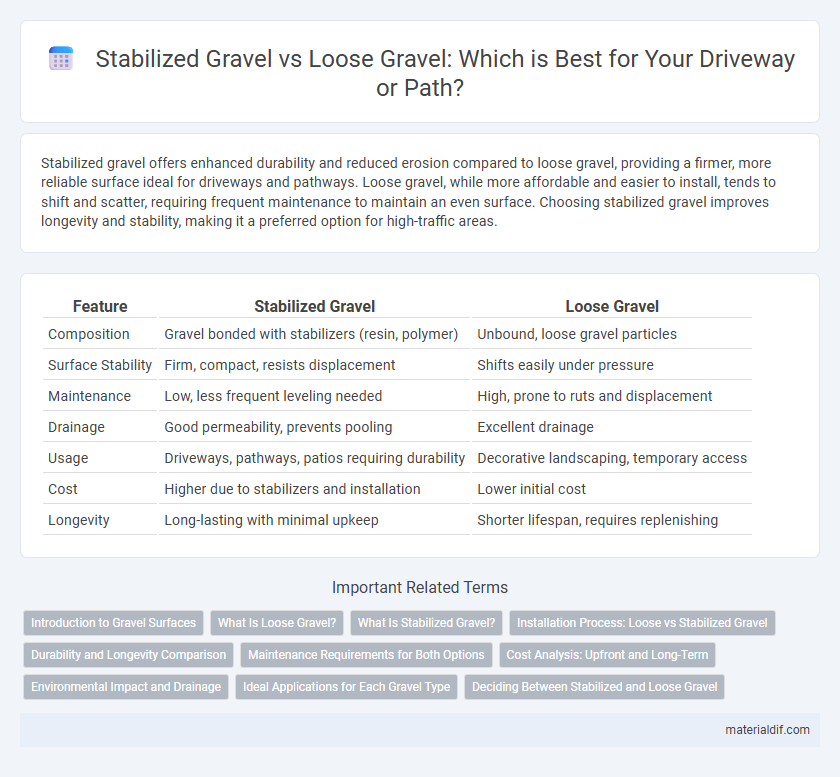Stabilized gravel offers enhanced durability and reduced erosion compared to loose gravel, providing a firmer, more reliable surface ideal for driveways and pathways. Loose gravel, while more affordable and easier to install, tends to shift and scatter, requiring frequent maintenance to maintain an even surface. Choosing stabilized gravel improves longevity and stability, making it a preferred option for high-traffic areas.
Table of Comparison
| Feature | Stabilized Gravel | Loose Gravel |
|---|---|---|
| Composition | Gravel bonded with stabilizers (resin, polymer) | Unbound, loose gravel particles |
| Surface Stability | Firm, compact, resists displacement | Shifts easily under pressure |
| Maintenance | Low, less frequent leveling needed | High, prone to ruts and displacement |
| Drainage | Good permeability, prevents pooling | Excellent drainage |
| Usage | Driveways, pathways, patios requiring durability | Decorative landscaping, temporary access |
| Cost | Higher due to stabilizers and installation | Lower initial cost |
| Longevity | Long-lasting with minimal upkeep | Shorter lifespan, requires replenishing |
Introduction to Gravel Surfaces
Stabilized gravel surfaces offer enhanced durability and reduced erosion compared to loose gravel, making them ideal for driveways, pathways, and patios requiring long-term stability. The binding agents in stabilized gravel prevent displacement, providing a firmer, more even surface that supports heavier loads and resists washouts. In contrast, loose gravel provides superior drainage and ease of installation but requires frequent maintenance to manage shifting and compaction.
What Is Loose Gravel?
Loose gravel consists of small, free-moving stones that are not bound together by any stabilizing material, resulting in a surface that can shift underfoot or vehicle tires. Commonly used for landscaping and pathways, loose gravel provides good drainage but may require frequent maintenance to keep it contained and evenly spread. Unlike stabilized gravel, it does not offer structural support and can be prone to erosion or displacement over time.
What Is Stabilized Gravel?
Stabilized gravel is a mixture of natural gravel combined with binding agents such as cement, polymers, or resins to create a firm and durable surface. This type of gravel offers enhanced load-bearing capacity, reduced dust, and minimal displacement compared to loose gravel. Stabilized gravel is commonly used in driveways, pathways, and construction projects requiring long-lasting, erosion-resistant surfaces.
Installation Process: Loose vs Stabilized Gravel
Loose gravel installation involves simply spreading and leveling the crushed stones, requiring minimal preparation and allowing for quick application but resulting in frequent displacement and maintenance. Stabilized gravel installation requires a base layer and the application of a binding agent or resin, which hardens to lock the particles together, offering enhanced durability, reduced erosion, and a firmer surface. The stabilized method demands more labor and time but provides long-term benefits for driveways, pathways, and landscaping projects.
Durability and Longevity Comparison
Stabilized gravel offers enhanced durability and longevity compared to loose gravel due to its binding agents that prevent displacement and erosion. The compaction and stabilization processes increase load-bearing capacity, reducing maintenance needs over time. Loose gravel tends to scatter and degrade faster under traffic and weather conditions, making it less suitable for long-term applications.
Maintenance Requirements for Both Options
Stabilized gravel requires less frequent maintenance due to its compacted and binding agents that prevent displacement and erosion, reducing the need for regular leveling or adding new material. Loose gravel demands ongoing upkeep, including periodic raking, refilling, and addressing washouts caused by weather or traffic. Choosing stabilized gravel minimizes maintenance time and costs, making it ideal for high-traffic driveways and pathways.
Cost Analysis: Upfront and Long-Term
Stabilized gravel typically incurs higher upfront costs due to additional materials and labor for binding agents or additives that enhance durability and reduce erosion. In contrast, loose gravel has lower initial expenses but often requires more frequent maintenance and replenishment, increasing long-term costs. Evaluating total investment over time reveals stabilized gravel as more cost-effective for reducing surface degradation and minimizing ongoing repairs.
Environmental Impact and Drainage
Stabilized gravel reduces erosion and prevents sediment runoff, minimizing environmental impact by maintaining soil integrity and protecting nearby water bodies. Loose gravel allows better natural water infiltration, enhancing drainage and reducing surface runoff, which benefits groundwater recharge. Choosing between stabilized and loose gravel depends on balancing soil conservation with optimal water drainage requirements in specific environmental conditions.
Ideal Applications for Each Gravel Type
Stabilized gravel provides a firm, durable surface ideal for driveways, walkways, and parking areas that require low maintenance and resistance to erosion. Loose gravel is best suited for garden paths, decorative landscaping, and drainage solutions where flexibility and natural appearance are priorities. Selecting between stabilized and loose gravel depends on the need for stability versus ease of installation and aesthetic preference.
Deciding Between Stabilized and Loose Gravel
Stabilized gravel offers enhanced durability and reduced erosion, making it ideal for driveways and pathways requiring long-term stability. Loose gravel provides better drainage and is easier to install but can shift under heavy traffic or weather conditions. Choosing between stabilized and loose gravel depends on factors like intended use, climate, maintenance willingness, and budget constraints.
Stabilized Gravel vs Loose Gravel Infographic

 materialdif.com
materialdif.com